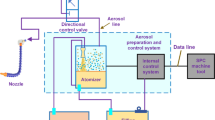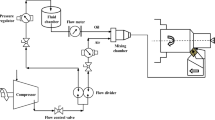Abstract
Rational parameters for the minimum quantity lubrication (MQL) are essential to reduce cutting temperature and extend tool life during titanium alloys’ milling processing. However, little research has been done on the effect of nozzle elevation angle on Ti-6Al-4V milling. This article’s objective is to experimentally elucidate the impact of various MQL parameters, including oil flow rate, nozzle distance, and nozzle elevation angle in the end-milling of Ti-6Al-4V. Response surface methodology (RSM) analyzes MQL parameters’ influence on the cutting temperature, milling force, and acceleration. Results demonstrated that cutting temperature first decreases and increases with the increase of the oil flow rate increased from 30 to 250 ml/h. When the nozzle distance is either too large or too small, the measured cutting temperature, cutting force, and acceleration are higher than those measured at a nozzle distance of 60 mm. The nozzle elevation angle is the predominant factor affecting the experimental results. And proper nozzle settings can reduce the cutting temperature by 15 °C, the cutting force by at least 5.6%, and the acceleration by 8.9%.









Similar content being viewed by others
References
Pervaiz S, Anwar S, Qureshi I, Ahmed N (2019) Recent advances in the machining of titanium alloys using minimum quantity lubrication (MQL) based techniques. International Int J Pr Eng Man-GT 6(1):133–145
Ezugwu EO, Bonney J, Yamane Y (2003) An overview of the machinability of aeroengine alloys. J Mater Process Technol 134(2):233–253
Zhou CA, Guo K, Sun J (2021) Sound singularity analysis for milling tool condition monitoring towards sustainable manufacturing. Mech Syst Signal Pr 157:107738
Zhou CA, Guo K, Zhao Y, Zan ZL, Sun J (2021) Development and testing of a wireless rotating triaxial vibration measuring tool holder system for milling process. Measurement 163:108034
Hong SY, Ding Y (2001) Cooling approaches and cutting temperatures in cryogenic machining of Ti-6Al-4V. Int J Mach Tool Manu 41(10):1417–1437
Zhou C, Guo K, Sun J, Yang B, Liu JW, Song G, Sun C, Jiang ZX (2020) Tool condition-monitoring in milling using a force singularity analysis approach. Int J Adv Manuf Technol 107(7-8):1785–1792
Shokrani A, Dhokia V, Newman ST (2012) Environmentally conscious machining of difficult-to-machine materials with regard to cutting fluids. Int J Mach Tool Manu 57:83–101
Sui S, Song G, Sun C, Zhu Z, Guo K, Sun J (2020) Experimental investigation on the performance of novel double cone integrated tool in one-shot drilling of metal stacks. Int J Adv Manuf Technol 109(9):523–534
Su Y, He N, Li L (2010) Experimental study on high speed milling titanium alloys using cryogenic minimum quantity lubrication. China Mechanical Engineering 21(22):2665–2670
Khan MMA, Mithu MAH, Dhar NR (2009) Effects of minimum quantity lubrication on turning AISI 9310 alloy steel using vegetable oil-based cutting fluid. J Mater Process Technol 209(15-16):5573–5583
Hegab H, Kishawy HA, Gadallah MH, Umer U, Deiab I (2018) On machining of Ti-6Al-4V using multi-walled carbon nanotubes-based nano-fluid under minimum quantity lubrication. Int J Adv Manuf Technol 97(5-8):1593–1603
Li CH, Li JY, Wang S, Zhang Q (2013) Modeling and numerical simulation of the grinding temperature field with nanoparticle jet of MQL. Adv Mech Eng 5:986984
Thakur DG, Ramamoorthy B, Vijayaraghavan L (2010) Investigation and optimization of lubrication parameters in high speed turning of superalloy Inconel 718. Int J Adv Manuf Technol 50(5-8):471–478
Sun J, Wong YS, Rahman M, Wang ZG, Neo KS, Tan CH, Onozuka H (2006) Effects of coolant supply methods and cutting conditions on tool life in end milling titanium alloy. Mach Sci Technol 10(3):355–370
Jiang F, Li JF, Sun J, Zhang S (2009) The effect of cooling lubrication methods on surface roughness measured by the white light interferometer. Adv Mater Res 76-78:471–478
Yasir A, Che Hassan CH, Jaharah AG, Norhamidi M, Gusri AI, Zaid AY (2010) Cutting force analysis when milling Ti-6Al-4V under dry and near dry conditions using coated tungsten carbides. Adv Mater Res 129:993–998
Yuan SM, Yan LT, Liu WD, Liu Q (2011) Effects of cooling air temperature on cryogenic machining of Ti-6Al-4V alloy. J Mater Process Technol 211(3):356–362
Cai XJ, Liu ZQ, Chen M, An QL (2012) An experimental investigation on effects of minimum quantity lubrication oil supply rate in high-speed end milling of Ti-6Al-4V. P I Mech Eng B-J Eng 226(11):1784–1792
Yanis M, Mohruni AS, Sharif S, Yani I, Suzen Z, Ahmad ZA (2019) Cutting force prediction when green machining of thin-walled Ti-6Al-4V under dry and MQL-cutting using response surface methodology and artificial neural networks-algorithm. AIP Conf Proc 2129(1):020027
Park KH, Yang GD, Lee MG, Jeong H, Lee SW, Lee DY (2014) Eco-friendly face milling of titanium alloy. Int J Precis Eng Manuf 15(6):1159–1164
Khatri A, Jahan MP (2018) Investigating tool wear mechanisms in machining of Ti-6Al-4V in flood coolant, dry and MQL conditions. Procedia Manuf 26:434–445
Liu Z, Chen M, An QL (2015) Investigation of friction in end-milling of Ti-6Al-4V under different green cutting conditions. Int J Adv Manuf Technol 78(5-8):1181–1192
Özbek O, Saruhan H (2020) The effect of vibration and cutting zone temperature on surface roughness and tool wear in eco-friendly MQL turning of AISI D2. J Mater Res Technol 9(3):2762–2772
Ni C, Zhu L, Yang Z (2019) Comparative investigation of tool wear mechanism and corresponding machined surface characterization in feed-direction ultrasonic vibration assisted milling of Ti–6Al–4V from dynamic view. Wear 436:203006
Shokrani A, Al-Samarrai I, Newman ST (2019) Hybrid cryogenic MQL for improving tool life in machining of Ti-6Al-4V titanium alloy. J Manuf Process 43:229–243
Bai X, Li C, Dong L, Yin Q (2019) Experimental evaluation of the lubrication performances of different nano-fluids for minimum quantity lubrication (MQL) in milling Ti-6Al-4V. Int J Adv Manuf Technol 101(9-12):2621–2632
Kim JS, Kim JW, Lee SW (2017) Experimental characterization on micro-end milling of titanium alloy using nano-fluid minimum quantity lubrication with chilly gas. Int J Adv Manuf Technol 91(5-8):2741–2749
Li M, Yu T, Zhang R, Yang L, Li H, Wang W (2018) MQL milling of TC4 alloy by dispersing graphene into vegetable oil-based cutting fluid. Int J Adv Manuf Technol 99(5-8):1735–1753
Hussain MI, Taraman KS, Filipovic AJ, Garrn I (2008) Experimental study to analyse the workpiece surface temperature in deep hole drilling of aluminium alloy engine blocks using MQL technology. J Achiev Mater Manuf Eng 31(2):485–490
Park KH, Olortegui-Yume J, Yoon MC, Kwon P (2010) A study on droplets and their distribution for minimum quantity lubrication (MQL). Int J Mach Tool Manu 50(9):824–833
Maruda RW, Krolczyk GM, Feldshtein E, Pusavec F, Szydlowski M, Legutko S, Sobczak-Kupiec A (2016) A study on droplets sizes, their distribution and heat exchange for minimum quantity cooling lubrication (MQCL). Int J Mach Tool Manu 100:81–928
Duchosal A, Werda S, Serra R, Leroy R, Hamdi H (2015) Numerical modeling and experimental measurement of MQL impingement over an insert in a milling tool with inner channels. Int J Mach Tool Manu 94:37–47
Tawakoli T, Hadad MJ, Sadeghi MH (2010) Influence of oil mist parameters on minimum quantity lubrication–MQL grinding process. Int J Mach Tool Manu 50(6):521–531
Rohit JN, Kumar KS, Reddy NS, Kuppan P, Balan ASS (2018) Computational fluid dynamics analysis of MQL spray parameters and its influence on MQL milling of SS304. Simul for Des Manuf. https://doi.org/10.1007/978-981-10-8518-5_2
Kim SH, Lee SW, Han S, Kim SM (2019) Numerical investigation of thermal characteristics of spray cooling with minimum quantity lubrication in milling process. Appl Math Model 65:137–147
Zhu G, Yuan S, Chen B (2019) Numerical and experimental optimizations of nozzle distance in minimum quantity lubrication (MQL) milling process. Int J Adv Manuf Technol 101(1-4):565–578
Kara F, Karabatak M, Ayyıldız M, Nas E (2020) Effect of machinability, microstructure and hardness of deep cryogenic treatment in hard turning of AISI D2 steel with ceramic cutting. J Mater Res Technol 9(1):969–983
Liu F, Li X, Li Y, Wang Z, Zhai W, Li F, Li J (2020) Modelling of the effects of process parameters on energy consumption for incremental sheet forming process. J Clean Prod 250:119456
Nas E, Altan Özbek N (2020) Optimization of the machining parameters in turning of hardened hot work tool steel using cryogenically treated tools. Surf Rev Lett 27(05):1950177
Guo K , Pan Y, Yu H (2018) Composite learning robot control with friction compensation: a neural network-based approach. IEEE T Ind Electron PP(99):1-1
Guo K, Zheng D, Li J (2021) Optimal bounded ellipsoid identification with deterministic and bounded learning gains: design and application to Euler-Lagrange systems. IEEE Trans Cybern:1–14. https://doi.org/10.1109/TCYB.2021.3066639
Kara F, Takmaz A (2019) Optimization by the Taguchi method of effect on the surface roughness of cryogenic treatment applied to cutting tools. Mater Test 61(11):1101–1104
Kara F (2018) Optimization of surface roughness in finish milling of AISI P20+S plastic mold steel. Mater Technol 52(2):195–200
Zhang Y, Guo K, Sun J (2019) Investigation on the milling performance of amputating clamping supports for machining with industrial robot. Int J Adv Manuf Technol 102:3573–3586
Mia M (2018) Mathematical modeling and optimization of MQL assisted end milling characteristics based on RSM and Taguchi method. Measurement 121:249–260
Liu ZQ, Cai XJ, Chen M, An QL (2011) Investigation of cutting force and temperature of end-milling Ti–6Al–4V with different minimum quantity lubrication (MQL) parameters. P I Mech Eng B-J Eng 225(8):1273–1279
Availability of data and materials
The datasets used or analyzed during the current study are available from the corresponding author on reasonable request.
Funding
This work was supported by the National Natural Science Foundation of China under Grant 51975335, Key R&D Program of Shandong Province under Grant 2019GGX104008, Grant 2019GGX104006, Grant 2019JZZY020318, 2019JZZY020313.
Author information
Authors and Affiliations
Contributions
Zhuoliang Zan: Validation, data curation, formal analysis, investigation, writing-original draft, writing-review and editing. Kai Guo: Writing-original draft, supervision, formal analysis, investigation, project administration, funding acquisition. Jie Sun: Writing-original draft, project administration, funding acquisition. Wei Xin, Yecheng Tan: Data acquisition. Yang Bin: Programming suggestions. All the authors have read and agreed to the manuscript.
Corresponding author
Ethics declarations
Ethical approval
Ethics approval was not required for this research.
Consent to participate
Written informed consent for participation was obtained from all participants.
Consent for publication
Written informed consent for publication was obtained from all participants.
Competing interests
The authors declare no competing interests.
Additional information
Publisher’s note
Springer Nature remains neutral with regard to jurisdictional claims in published maps and institutional affiliations.
Rights and permissions
About this article
Cite this article
Zan, Z., Guo, K., Sun, J. et al. Investigation of MQL parameters in milling of titanium alloy. Int J Adv Manuf Technol 116, 375–388 (2021). https://doi.org/10.1007/s00170-021-07441-4
Received:
Accepted:
Published:
Issue Date:
DOI: https://doi.org/10.1007/s00170-021-07441-4




